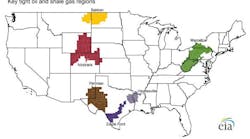The key factors driving recent growth in domestic production of oil and natural gas are improved drilling efficiency and well productivity, not an increase in the number of active rigs.
That is one of the key findings presented in the inaugural Drilling Productivity Report, a new monthly publication produced by the U.S. Energy Information Administration.
The EIA's report assesses productivity from six active shale formations that account for virtually all of the recent growth in the domestic production of oil and natural gas: the Bakken Shale, which underlies parts of North Dakota and Montana; the Niobrara Shale, Wyoming, Colorado, Nebraska and Kansas; the Permian Shale, Texas and New Mexico; the Eagle Ford Shale, Texas; the Haynesville Shale, Texas, Louisiana and Arkansas; and the Marcellus Shale, West Virginia, Pennsylvania and New York.
Additional Conclusions
Other key findings from the EIA's inaugural monthly Drilling Productivity Report:
1. The Bakken and Eagle Ford formations together account for about 75% of the current growth in monthly oil production tracked by the EIA. Over the past year, production from those two shale formations grew by about 700,000 barrels per day.
2. The Permian Shale, which grew by 93,000 barrels per day year-over-year, remains the biggest oil producer in absolute terms.
3. The Marcellus Shale accounts for about 75% of the growth in the domestic production of natural gas tracked by EIA.



